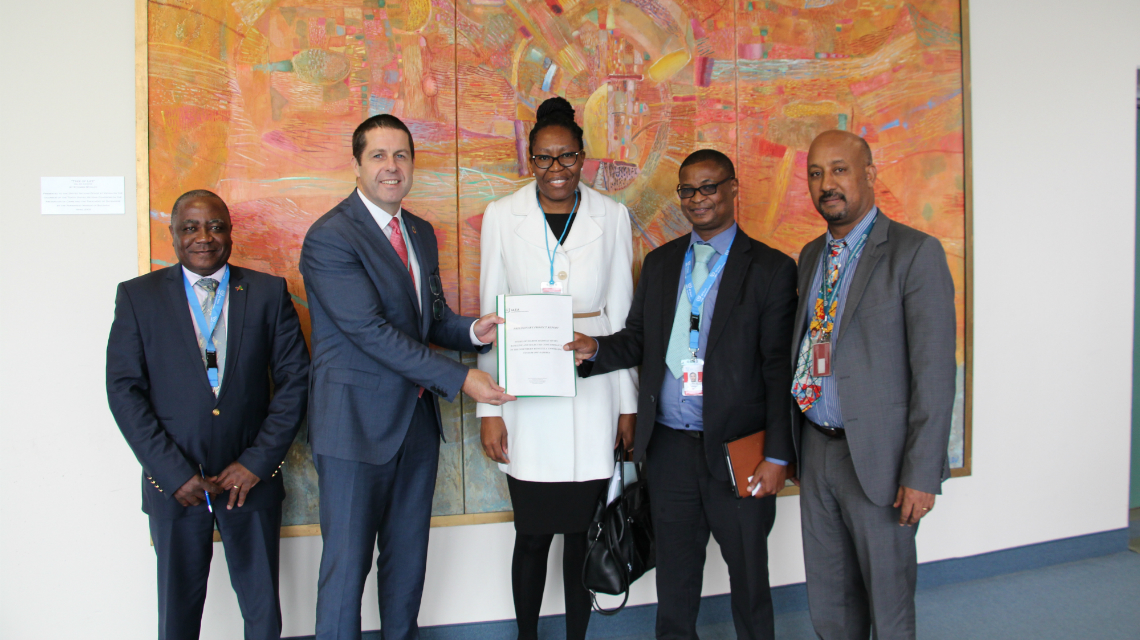The coastline of Namibia is a lively place. A large ecosystem on the edge of southwest Africa, it teems with biodiversity and stretches along the South Atlantic’s turbulent Benguela current for over 1500 km. It is a highly dynamic environment. Strong winds, seething currents, and underwater sulphur eruptions surround rich stocks of fish, plankton, and other marine life, including the world’s largest bacteria (a whopping one millimetre long—visible to the naked eye).
Increasing human activities have added to the mix. The seaside features valuable fisheries, mariculture industries, and a swelling population. There are also mining activities close to the Namibian shore. Uranium is being extracted, along with diamonds and gold, and there is now a growing interest in seabed mining for phosphates. Despite all this fizzing activity, little was known about Namibia’s levels of marine radioactivity and trace metal pollution until recently.
At the IAEA’s General Conference in Vienna last week, a preliminary project report on the study of Marine Radioactivity Baseline and Selected Contaminants in the Northern Benguela Upwelling System off Namibia was released to the Namibian government with up-to-date research results. New publications will continue to come out as further analysis is performed on the rich variety of collected samples. With the help of this knowledge, the ecosystem will be better protected—for humans and big bacteria alike.
Beginning in 2014, at the request of Namibia’s Ministry of Fisheries and Marine Resources (MFMR), the IAEA Environment Laboratories began collecting a diverse range of marine samples off the coast. The growing coastal activities mean new regulations are needed to monitor and manage natural and anthropogenic (i.e. human-caused) radionuclides and trace metals that may contaminate the marine ecosystem—and with it, seafood.
Seafood exports form a large part of Namibia’s economy. Gathering marine samples allows researchers to obtain baseline measurements of contaminants; these measurements, and the understanding of area-wide oceanic processes they enable, are necessary to monitor pollutants in the marine environment and in the food chain, which can cause harm to humans and other organisms.
Collecting and studying samples off the Namibian coast is challenging work. Tumultuous currents from the Benguela system can violently rock research vessels, turning a bumpy ride into a seasick one. But this commotion disturbs more than just the bellies of researchers; layers of sediment are continuously mixed by the churning waters, muddying attempts to unravel the ecosystem’s past.
Despite these challenges, gathering and analysing these samples is vital for Namibia. It will allow researchers and regulators to better understand threats to the marine environment. In addition to establishing baseline measurements for regulation and ongoing pollution assessment, radionuclides can serve as radiotracers to better understand oceanographic processes in the area. (See below for a more detailed explanation of the science).
“One of the reasons this project worked so well is the strength of our collaborations,” says Martina Rozmaric, a scientist at the IAEA Environment Laboratories. “Altogether, over ten institutions from six countries worked together. We all knew how beneficial this knowledge would be.”
This research not only helps Namibia, but will also continue to add international scientific value by improving knowledge of global patterns of marine pollution. In studying the presence of natural and anthropogenic radionuclides and trace metals (such as lead, copper, cadmium, and arsenic) off Namibia’s seaboard, a critical knowledge gap on the world map is being filled in.
Deon Louw, a marine scientist at the National Marine Information Research Centre and the chief Namibian researcher on this project, is optimistic about the value of this work. “This baseline study is the first step to understanding our marine radioactivity levels,” he said. “We need this knowledge to monitor and protect our marine ecosystem as human activity continues to rise.”
"This baseline study is the first step to understanding our marine radioactivity levels. We need this knowledge to monitor and protect our marine ecosystem as human activity continues to rise."



